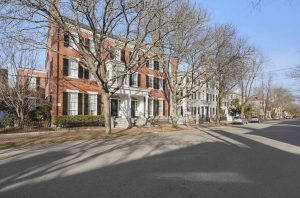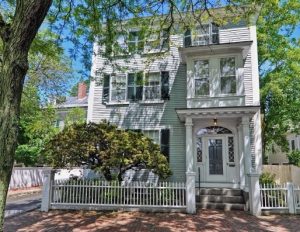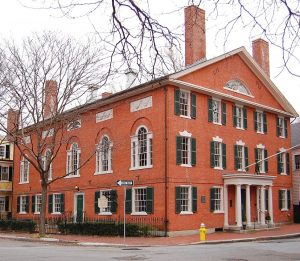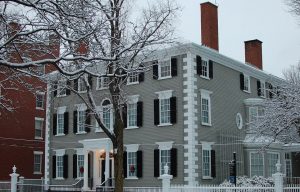A view down Chestnut Street
Chestnut Street, right around the corner from the Inn, is a treasure trove of architectural beauty. Mostly built between 1796 and 1805 on farmland, its stately mansions were homes to wealthy sea captains and merchants looking to find some peace away from Salem’s busy waterfront. The houses are examples of Federal architecture, with additions and modifications made as styles changed and homeowners kept up with current trends.
But don’t be fooled by their rather plain exteriors. While the outsides were flat and relatively simple, the interiors were influenced by motifs and materials from the far east, brought back to Salem in ships engaged in the China trade. Hand-printed wallpaper, silks, porcelain adorned their homes. In the late 1800s, Asian influence extended to the exterior of the homes in the forms of fan windows, geometrical motifs, and overlapping ovals in the windows, fences, and balusters. You can learn more about the China trade at the Salem Maritime National Historic Site as well as at the Peabody Essex Museum. Many of the homes still retain some original interior design.
An example of a fan window and decorative side lights
Hamilton Hall, named after Founding Father Alexander Hamilton, is a few doors down on your left if you’re walking from the Inn. It was designed by one of the time’s most famous architect and woodcarver, Samuel McIntire. In fact, all of Chestnut Street falls within what is called the McIntyre District as many of the homes here were designed by him. Hamilton Hall was built for Salem’s most prestigious families to have a place to socialize. It still functions as a lecture hall, wedding venue, and ballroom. It is an excellent example of Federal style architecture.
Hamilton Hall
The Phillips House, about halfway down the street on your right if you are walking from the Inn, has a direct connection to the Salem Inn, and quite a scandalous one at that. Nathaniel West, the mariner who built the West House of the Inn, also built with his bride, Elizabeth Derby, a country estate in the nearby town of Danvers. Nathaniel West was wealthy from his merchant trading, and Elizabeth from being the daughter of America’s first millionaire, Elias Hasket Derby. Their marriage was a tumultuous one, and the Wests got divorced in 1806, when the laws involving ownership of property changed to allow wives to keep their share of property if they could prove their husbands’ adultery. Elizabeth did this by parading prostitutes from Salem’s brothels through the court, much to society’s chagrin. Elizabeth was granted the house in Danvers, but Nathaniel eventually reinherited a third of it after her death in 1813. So how did it get to Chestnut Street? Nathaniel had his share, the front four rooms, moved to Salem by oxen. He then added a hallway, back addition, and a third floor. The house changed hands several times until Stephen Phillips bought it in 1911 and lived there with his family until he died in 1955. You can visit the house, which still has the Phillips’ original furnishings and collections from their travels—click here for touring hours. It is the only house on Chestnut Street open to the public. We highly recommend seeing this well-preserved piece of the past!
Phillips House
~Jill Pabich, September 9, 2022





Comments 1
Nice blog, Jill!
I have started giving my free two-hour walking tour of Salem. I don’t have a website yet, but I do have a page on Facebook named “Salem History Tour For You” and I just created an Instagram page called salem.history.tour. Perhaps some of your guests would like this history tour. I tell the story about Capt. West’s divorce.